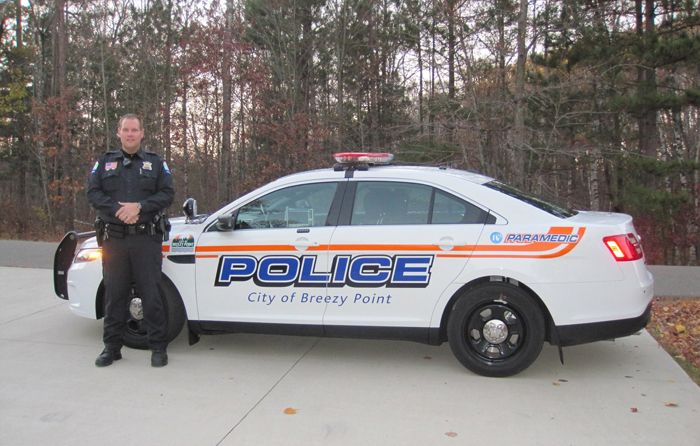In Breezy Point, Minn., two police officers are dual-trained as paramedics to provide rapid EMS response while also saving the community the expense of creating its own ambulance service.
Those who are not accustomed to seeing this double role are caught by surprise. “It gets to be kind of comical,” says police officer and paramedic Jason Rieber, describing how some are alarmed when they see a police officer doing an IV.
The novel approach to providing EMS is acknowledgment of the difficulty of staffing an EMS service with volunteers or paid staff in a rural area. Minnesota’s eastern neighbor, Wisconsin, is considering legislation to reduce the number of EMTs required on an ambulance from two to one.
Police paramedics
An EMS delivery model that is slowly becoming more popular is that of police paramedics, police officers who are trained paramedics and respond to medical and trauma emergency calls. Breezy Point, a community of 2,400 residents that can reach 15,000 during summer resort season adopted this model in 2005.
The city was experiencing a dramatic increase in EMS requests. But while local police and medical first responders could reach the incident location within minutes, an ambulance coming from neighboring cities Crosslake, Pine River or Brainerd could take 15-20 minutes. Furthermore, those ambulances weren’t available 24/7 and if they were already responding to other calls, response times could significantly increase.
When establishing a city-owned ambulance service or contracting with one was going to be too costly, Breezy Point decided to partner with the North Memorial Ambulance Service and create a public-private partnership for police paramedics.
The ambulance service provides equipment and medicines, and the city pays for training and education. Since the Breezy Point Police Department already had two certified paramedics among its six officers, the city saved money in training. The program, covering Breezy Point and Pelican Township, costs the city between $14,000 and $20,000 annually. To fully staff an ambulance service would cost about $400,000 per year.
A challenging and rewarding role
Today, the department still has two paramedic officers out of six full-time and three part-time officers. Rieber became a police officer in 2007, after being a paramedic for 12 years. All the other officers are medical first responders and Chief Kevin Merschman is a certified EMT.

Police paramedic Jason Rieber (Courtesy photo)
The duality of the role can be challenging because sometimes a situation requires an officer and a paramedic on the same scene. Rieber says making sure the scene is safe is always the top priority. “At the end of the day we are still a police department first and police paramedics second,” he says.
Police paramedics Josef Garcia and Rieber work primarily at night, when the ambulance response times are the longest. They also wear pagers when they are not on duty and have personally assigned squad cars equipped with all the equipment needed for ALS procedures. “We can basically do everything ambulances can do besides transport,” Rieber says.
After assessing the patient and beginning care, the police paramedics wait for the ambulance or air medical service to transport the patient to the hospital, the closest being about 20 miles away. Considering traffic and road conditions, transport can take anywhere from 15-30 minutes, so the role of police paramedic is crucial.
Equipped with Lucas automatic chest compression devices and King Vision laryngoscopes, the police paramedics are able to improve the patients’ survival chances, even when they respond by themselves.
In December 2012, Marge Olek suffered a heart attack. Rieber was the first paramedic on scene, and thanks to the chest compression device, he was able to perform other interventions for Olek while the device delivered CPR. Olek’s life was saved and for his efforts, Rieber was given a life-saving award by the city.
Cooperative effort
While they certainly make a difference, Rieber emphasizes that their police paramedic program is successful thanks to the cooperation of everyone involved in patient care — first responders, assisting officers and the transport ambulance. “Without everyone, we are no one,” Rieber says.
Since the volume of medical emergency calls can vary greatly depending on the season, going from eight calls a day to eight days without a call, Rieber and Garcia maintain their EMS proficiency by working part time for North Memorial Ambulance Service. This is part of their contract as police paramedics.
Rieber and Garcia also need to continue their education like any other police officer and paramedic. “It’s a lot of extra work,” Rieber says. Besides their regular police shifts, the two each work 24 hours a week on an ambulance.
Other Breezy Point police paramedics Dan Sathre and Garcia have been recognized, respectively in 2006 and 2007, with the Minnesota Ambulance Association Star of Life Award. In 2008 the city received the City of Excellence Award from the League of Minnesota Cities for the innovative program.
While police paramedics are part of the EMS response in other communities, they are still a new concept to many. Like Breezy Point, some other rural areas are seeing a decline in volunteers. “To combat that, programs like this could step up and start filling the void,” Rieber says, in particular in those areas with extended response time where the capital for a full-time staffed ambulance service is not available. “In areas like that this program could shine.”











